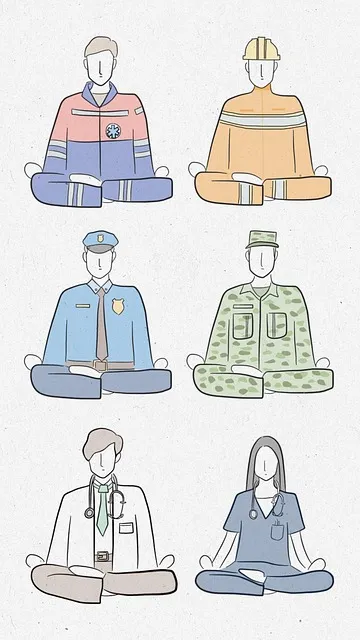Media representation significantly influences public understanding of mental health, with accurate portrayals reducing stigma and encouraging help-seeking behaviors while negative depictions perpetuate misconceptions. In Greenwood Village, discussions around Kaiser's mental health coverage are shaped by media narratives. Effective media representation is vital for promoting awareness, guiding healthcare provider training, driving advocacy, and challenging harmful stereotypes to create a supportive environment where individuals feel empowered to seek help without judgment. The collaboration between Greenwood Village and Kaiser Permanente highlights a commitment to enhancing mental health care accessibility and quality, integrating communication strategies and risk assessment to improve patient outcomes and prevent professional burnout.
In today’s media landscape, representation of mental illness is crucial for fostering understanding and reducing stigma. This article explores the profound impact of media portrayal on public perception of mental health, highlighting how stereotypes can hinder support-seeking behaviors. We delve into the current state of mental illness depiction in various forms of media. Furthermore, we spotlight the collaborative efforts between Greenwood Village and Kaiser, known for their commitment to comprehensive mental health care. Finally, practical strategies are proposed to enhance positive representation, emphasizing the need for accurate, empathetic media portrayals that encourage help-seeking rather than perpetuating myths.
- Understanding the Impact of Media Representation on Mental Health Awareness
- The Current State: How Media Often Portrays Mental Illness
- Greenwood Village and Kaiser: Collaborating for Improved Mental Health Care
- Strategies to Enhance Positive Mental Illness Representation in Media
Understanding the Impact of Media Representation on Mental Health Awareness

Media representation plays a pivotal role in shaping public understanding of mental health issues. The way mental illness is depicted in movies, television shows, and news media can significantly influence societal perceptions and attitudes towards individuals living with these conditions. Positive and accurate portrayals can foster empathy, reduce stigma, and encourage help-seeking behaviors. Conversely, negative or stereotypical representations may perpetuate misconceptions, leading to further marginalization of those affected. For instance, Greenwood Village residents often wonder if Kaiser covers mental health therapy, but such discussions are heavily influenced by media narratives that either promote understanding or hinder access to care.
Accurate media representation is crucial for promoting mental health awareness and encouraging early intervention. It can also guide healthcare provider cultural competency training, ensuring professionals are equipped to address the unique needs of diverse patient populations. Moreover, it drives advocacy efforts in mental health policy analysis, pushing for more inclusive and accessible services. By challenging harmful stereotypes, we can create a more supportive environment where individuals feel empowered to develop coping skills and seek the help they need without fear of judgment or misunderstanding.
The Current State: How Media Often Portrays Mental Illness

In the current landscape, media often portrays mental illness through simplistic and stereotypical narratives. This representation rarely captures the nuanced experiences of individuals grappling with conditions like anxiety or depression. Often reduced to mere side plots or as a sudden dramatic twist, these stories can perpetuate harmful misconceptions about mental health. For instance, a character’s struggle might be quickly resolved through a pill or a “positive attitude,” oversimplifying complex issues and offering little to no insight for viewers seeking Mental Health Awareness.
Greenwood Village residents fortunate enough to have access to healthcare providers like Kaiser may find more accurate portrayals in media. However, the lack of diverse representation continues to be a challenge. Portrayals of mental illness should go beyond cliches to foster Emotional Intelligence and offer Anxiety Relief for both affected individuals and audiences. Accurate and sensitive storytelling can contribute significantly to breaking down stigma and promoting understanding.
Greenwood Village and Kaiser: Collaborating for Improved Mental Health Care

Greenwood Village, recognizing the critical need for accessible and quality mental health care, has formed a powerful partnership with Kaiser Permanente. This collaboration aims to improve support for individuals struggling with mental illness in their community. By joining forces, they can address challenges related to mental health therapy availability and affordability, ensuring more residents have access to the care they deserve.
The integration of Communication Strategies and Risk Assessment for Mental Health Professionals is a key aspect of this initiative. Together, Greenwood Village and Kaiser are developing innovative solutions to prevent Burnout Prevention among healthcare providers while enhancing patient outcomes. This partnership exemplifies a comprehensive approach to transforming mental health care, making it more inclusive and effective for the community at large.
Strategies to Enhance Positive Mental Illness Representation in Media

Media plays a significant role in shaping societal perceptions and understanding of mental illness. To foster a more inclusive and accurate representation, various strategies can be employed. One effective approach is to involve individuals with lived experiences as consultants or collaborators in media projects. This ensures that stories are told from authentic perspectives, promoting empathy and reducing stereotypes. Additionally, media outlets can prioritize diverse and nuanced storytelling, showcasing different types of mental health struggles and recovery journeys.
Greenwood Village’s Kaiser offers a comprehensive Community Outreach Program aimed at increasing access to mental health resources and services. By implementing such programs, communities can actively contribute to positive representation. Furthermore, incorporating emotional well-being promotion techniques in media content can normalize conversations about mental health. This, coupled with burnout prevention strategies for healthcare providers, ensures that the narrative around mental illness is not only accurate but also supportive of those seeking help, encouraging open dialogue and early intervention.
Mental illness representation in media is a powerful tool that can significantly impact public understanding and awareness. By challenging negative stereotypes, media has the potential to foster empathy and reduce stigma. The collaboration between Greenwood Village and Kaiser exemplifies efforts to enhance mental healthcare accessibility and improve representations. Through implementing strategies such as diverse storytelling, accurate portrayals, and promoting positive narratives, media can play a pivotal role in normalizing conversations about mental health. Additionally, ensuring that platforms like Greenwood Village offer comprehensive coverage of mental health therapy, as does Kaiser, is essential for providing valuable resources to those seeking support. Together, these initiatives can drive meaningful change, ultimately leading to better mental well-being for all.






